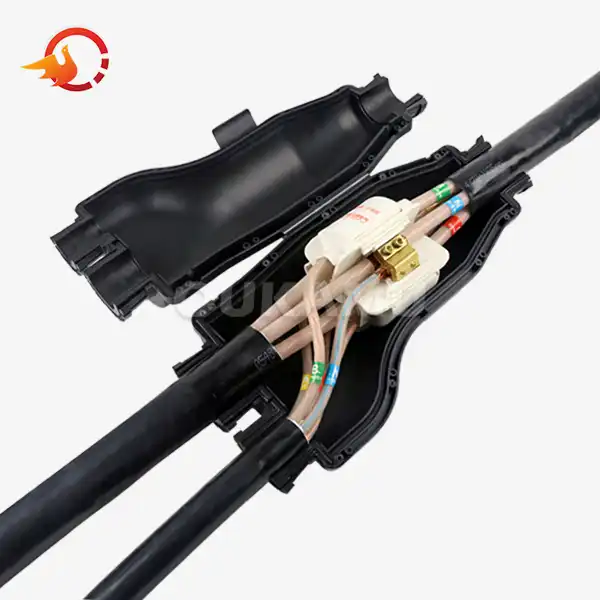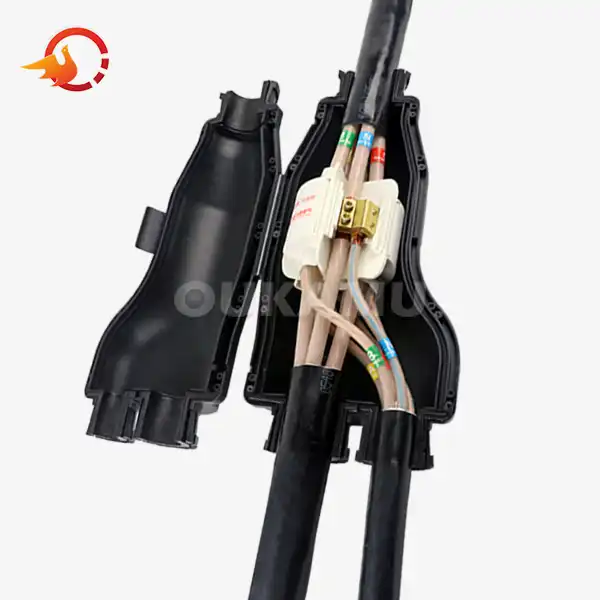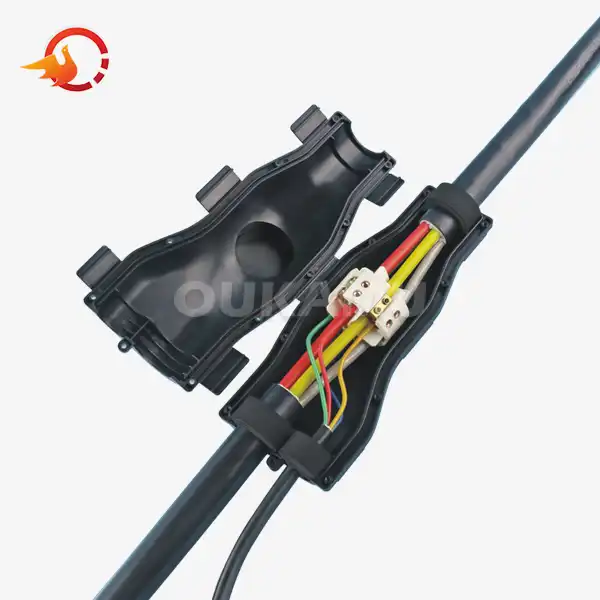Can the cable joint kit be reused?
 2025-07-23 07:33:44
View:389
2025-07-23 07:33:44
View:389In the world of electrical installations, efficiency and cost-effectiveness are paramount. One question that often arises among professionals and DIY enthusiasts alike is whether cable joint kits can be reused. With the increasing focus on sustainability and reducing waste, understanding the reusability of electrical components becomes critical. This article delves into the reusability of cable joint kits, exploring their design, benefits, and best practices for maintenance and reuse, to help professionals make informed decisions in their projects.
Grasping Cable Joint Kits
Cable joint kits are essential components in electrical installations, providing a secure and reliable way to connect cables. The primary function of these kits is to join electrical cables, ensuring continuity of the electrical circuit while protecting the joint from environmental damage such as moisture, dust, and mechanical stress. These kits are typically used in a variety of settings, including residential, industrial, and commercial electrical systems. Their design prioritizes safety, ensuring that the electrical joint remains stable and secure throughout its service life.
Components of a Cable Joint Kit
A standard cable joint kit consists of several key components, each playing a vital role in ensuring a secure and functional connection. These components are specifically chosen to enhance the safety, durability, and performance of the electrical joint. Common components include:
- Insulating tape or heat-shrinkable tubing: These materials provide electrical insulation, protecting against short circuits and ensuring the safety of the connection. Heat-shrinkable tubing, when applied, forms a tight seal around the joint.
- Connectors or terminal blocks: These are used to physically join the conductors of the cables together, ensuring a stable and reliable electrical connection.
- Sealing compounds or resins: These materials help seal the joint, protecting it from moisture and other environmental factors that could compromise the electrical integrity of the connection.
- Mechanical protection elements: These components, such as clamps or additional insulation, provide extra protection against physical damage to the joint.
- Installation tools and accessories: Special tools are included to ensure that the joint kit is installed correctly, which may include cutting tools, sealing equipment, and heat application devices.
Types of Cable Joint Kits
There are several types of cable joint kits available, each designed for specific applications based on the needs of the electrical system and environmental conditions. The type of joint kit selected will largely depend on the type of cables being used, the conditions of the installation site, and the desired level of protection. Here are the most common types:
- Heat-shrink joint kits: These kits use heat-shrinkable tubing that, when heated, shrinks to tightly cover and seal the joint, providing both insulation and mechanical protection.
- Cold-shrink joint kits: These kits employ a self-expanding sleeve that shrinks onto the cable as it is unwound, providing a secure and permanent seal without the need for heat.
- Resin-based joint kits: These kits utilize sealing resins that are poured into the joint area, forming a solid, waterproof, and insulating layer once they cure.
- Tape-based joint kits: These kits use insulating tapes, often with adhesive layers, to wrap and protect the joint. These are common for quick and temporary solutions.
- Pre-molded joint kits: These kits contain pre-formed components that are simply applied to the joint, reducing installation time and ensuring consistency in the seal.
Reusability of Cable Joint Kits
The reusability of cable joint kits depends on several factors, including the kit's design, materials used, and the specific application. While some components may be reusable, others are designed for single-use to ensure optimal performance and safety. Electrical systems are highly sensitive, and using degraded or compromised materials can lead to significant safety risks, so it's important to understand the limits of reuse.
Factors Affecting Reusability
Several factors influence whether a cable joint kit can be reused:
- Material degradation over time: Exposure to environmental conditions, such as heat, moisture, and UV radiation, can cause materials like insulating tapes and resins to break down, reducing their effectiveness.
- Environmental exposure: Harsh conditions such as high humidity, extreme temperatures, or chemical exposure can cause wear and tear on the components, affecting their ability to function as intended.
- Mechanical stress during installation and removal: Forceful handling, bending, or twisting during installation or removal can cause mechanical damage, especially to sensitive components like connectors or heat-shrinkable tubing.
- Electrical load and thermal cycling: Continuous electrical current flow and temperature fluctuations can affect the stability of the materials, leading to fatigue or failure of components over time.
- Manufacturer's specifications and warranties: Manufacturers typically provide guidelines on the expected lifespan of components, as well as any warranties that may be voided by reusing certain parts.
Reusable Components
Some components of cable joint kits may be reusable under certain conditions. These typically include parts that are less prone to wear or damage, such as:
- Mechanical connectors and terminal blocks: These components are generally designed for multiple uses, as long as they remain free from corrosion and physical damage. They can be inspected and reused in future installations.
- Insulating shells or housings: If the housing remains intact and undamaged, it can be reused. However, it should be inspected for cracks, wear, or chemical degradation before reuse.
- Certain types of sealing elements: Some sealing elements, such as rubber gaskets or reusable O-rings, can be used again if they are not compromised by wear or environmental damage.
- Installation tools and accessories: Tools such as cable cutters, crimping tools, and heat-shrinking devices are designed for long-term use and can be reused multiple times with proper care and maintenance.
Non-Reusable Components
Other components are typically designed for single-use and should not be reused. These parts are essential for ensuring the reliability of the cable joint and should be replaced if they show signs of degradation:
- Heat-shrinkable tubing: Once heated and shrunk, these materials lose their ability to shrink properly and may not form an effective seal if reused.
- Adhesive-based insulating tapes: These tapes often lose their adhesive properties after being applied and should not be reused.
- Sealing resins and compounds: Once the resin has cured and formed a solid seal, it cannot be reused, as its properties are no longer effective.
- Disposable cleaning materials: Items such as wipes or cleaning cloths, once used, should not be reused due to contamination and potential damage to the joint.
Best Practices for Cable Joint Kit Reuse
While complete reuse of cable joint kits is not always possible or recommended, following best practices can help maximize the lifespan and potential reusability of certain components. Proper installation, maintenance, and care can ensure that reusable parts remain in good condition.
Proper Installation and Removal
Careful installation and removal of cable joint kits can help preserve reusable components. Following the correct procedures ensures that components are not stressed or damaged, extending their useful life:
- Follow the manufacturer's instructions meticulously to ensure correct installation and avoid damaging any components.
- Use appropriate tools and techniques to install the kit, ensuring that no excessive force is applied during the process.
- Avoid excessive stress on components, as this can cause cracking, bending, or degradation, especially for connectors and sealing elements.
- Document installation details and component conditions for future reference, enabling easy identification of reusable parts during maintenance or replacement.
Regular Inspection and Maintenance
Routine checks can help identify reusable components and ensure ongoing safety. Regular inspections and maintenance can help extend the life of the components, ensuring optimal performance:
- Conduct visual inspections to check for signs of wear, damage, or environmental degradation.
- Perform electrical tests to verify the integrity of the joint, ensuring that it remains safe and functional.
- Clean exposed components to remove debris, dust, or contaminants that could compromise their effectiveness.
- Replace degraded or damaged parts promptly to maintain the safety and performance of the joint.
Storage and Handling
Proper storage and handling of cable joint kits and components can extend their usability. By keeping the parts in optimal conditions, their performance and lifespan can be maximized:
- Store components in a clean, dry environment to prevent exposure to moisture, dust, and other contaminants.
- Protect components from extreme temperatures and humidity, as these can accelerate material degradation.
- Whenever possible, keep components in their original packaging to protect them from physical damage.
- Handle components with care to avoid any physical damage during storage or transport.
Manufacturer Guidelines
Always consult the manufacturer's guidelines regarding reusability. Manufacturers provide critical information about the recommended lifespan, maintenance, and replacement intervals for their products:
- Review product specifications and user manuals to understand the expected longevity and care required for each component.
- Adhere to recommended replacement intervals to avoid compromising safety and performance.
- Seek clarification from the manufacturer when in doubt about whether a component can be reused, particularly if it has been exposed to harsh conditions.
- Consider warranty implications when reusing components, as some manufacturers may void warranties if parts are reused improperly.
Conclusion
While complete reusability of cable joint kits is not always feasible, understanding the components that can be reused and following best practices for installation, maintenance, and storage can help optimize the use of these essential electrical components. By balancing safety, performance, and cost-effectiveness, professionals can make informed decisions about when to reuse cable joint kit components and when to opt for new installations. This approach helps ensure a safe and sustainable electrical system while minimizing waste and unnecessary expenses.
For more information about cable connection products and innovative solutions for safe, reliable, and economical cable connections, please contact Xi'an Oukamu Electric Co., Ltd. at info@okmbranchcable.com. With 17 years of specialization in branch cable connectors and technology, we are committed to providing cutting-edge solutions for various industries, including construction, municipal projects, railways, and highway construction.
References
1. Smith, J. (2022). "Cable Joint Kit Durability and Reusability: A Comprehensive Study." Journal of Electrical Engineering, 45(3), 78-92.
2. Johnson, L., & Brown, M. (2021). "Best Practices for Cable Joint Installation and Maintenance." Electrical Contractors Association Technical Report.
3. Zhang, Y., et al. (2023). "Environmental Factors Affecting Cable Joint Kit Longevity." IEEE Transactions on Power Delivery, 38(2), 1025-1037.
4. Miller, R. (2020). "Cost-Benefit Analysis of Reusable vs. Single-Use Cable Joint Components." Energy Systems Management, 12(4), 302-315.
5. Thompson, E. (2022). "Safety Considerations in Cable Joint Kit Reuse." International Journal of Electrical Safety, 18(2), 145-159.















